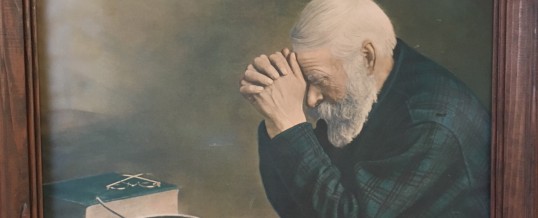
When I was a child, there was a painting that hung on my grandmother’s kitchen wall. It portrayed a man who was praying over a meal of bread and what appeared to be a bowl of soup. Near the man was a book, which I always assumed was a Bible, and a pair of spectacles.
From my earliest recollections until my dad’s mother passed, I remember looking at this painting while we ate in her home and wondering many things. Who was the man in the painting? Was he a real man or did he originate in the artist’s imagination? How old was the painting?
I never asked my grandmother about the image. Honestly, it never occurred to me that one day it would matter much. But something happened recently that changed that.
Several months ago, I expressed on my Facebook page that the painting meant a lot to me. I don’t recall if someone had posted a photo of it or how I came to make the comment, but my aunt saw my post and messaged me.
She owns a resale shop in my hometown and said that she could get me a copy of it. I offered to pay her, but she wouldn’t let me. She also had shared family meals in the same kitchen and remembered the photo.
After my aunt acquired a framed copy for me and my mom picked it up and delivered it during a recent visit, I did some homework on the painting.
I was surprised by what I learned.
The painting isn’t a painting. It is a photograph.
The Bible isn’t a Bible. It is a dictionary.
There’s more.
Here’s how the story goes:
Somewhere between 1918-1920, the photo was taken in a studio in Bovey, Minnesota, by a man named Eric Enstrom. The date the photo was actually captured varies because Enstrom’s daughter, who was born in 1917, claimed that she remembered it being taken.
Regardless of the date discrepancy, we do know that the man in the photo was named Charles Wilden. According to a number of online sources, Wilden was a Swedish immigrant who lived in Grand Rapids, Minnesota, a city located about eight miles from Bovey. He made his living as a peddler. According to one account, Wilden stopped by Enstrom’s studio to sell shoe scrapers and was convinced to pose for a photo.
Enstrom placed the dictionary, food, silverware, and the eyeglasses on the table and had Wilden bow his head in prayer. He then took the photo.
Enstrom said that when he developed the picture, he knew he had something special.
An excerpt from the website gracebyenstrom.com:
“There was something about the old gentleman’s face that immediately impressed me. I saw that he had a kind face… there weren’t any harsh lines in it,” Enstrom said in recalling the 1918 visit of Charles Wilden to his studio.
It happened that Enstrom, at that time, was preparing a portfolio of pictures to take with him to a convention of the Minnesota Photographer’s Association. “I wanted to take a picture that would show people that even though they had to do without many things because of the war they still had much to be thankful for,” Enstom said.”
According the site, Enstrom said he felt the photo seemed to be saying, “This man doesn’t have much of earthly goods, but he has more than most people because he has a thankful heart.”
The US had just reluctantly entered World War I, and understandably, everyone was worried and fearful.
At first, Enstrom made one print at a time and put them in the window of his photo studio. The copies sold quickly. He made more. Many more.
Enstrom’s daughter would later hand color copies of the photo, which is the version that most of us recognize today. Soon, that version would be seen, loved, and sold throughout the world.
In 1926, Enstrom paid Wilden for all rights to the photo. One online entry mentions that after that contractual agreement, Wilden was not seen again. No one knows his fate.
A modest salesman from a small Minnesota town likely lived the remainder of his days feeling that his life had been of minimal importance. Yet, nothing could be further from the truth.
Charles Wilden attained an immorality that few ever do. But, it isn’t his name that is immortal. It is his brief action in front of a camera almost 100 years ago that God used to send a message of faith for generations to come.
A message of faith that resonated with millions, including my grandmother. A message of her faith, and later mine, that was conveyed to me through a copy of a powerful photo that hung on her kitchen wall.
A photo that I now own. A photo titled, “Grace.”
©2016 John Moore
To read additional blogs, visit johnmoore.net/blog
photo: Print from John Moore’s personal collection
NOV
2016
